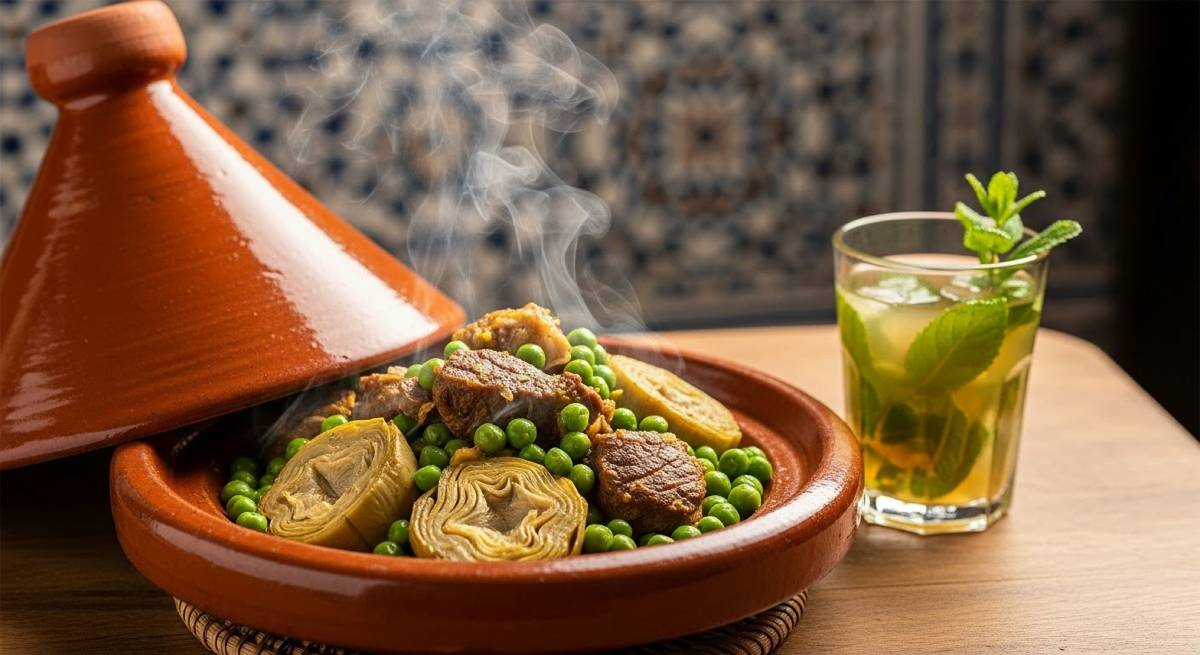
Table of Contents
A Hungry Question on the Road to Ouzoud
Tagine cooking is not just about cooking—it’s a story, a journey, and this is one of those moments.
Some days, you are just a taxi driver. Other days, you are an ambassador. A storyteller. This is a memory from one of those days.
I had good company in my old Mercedes: two English couples. One man beside me. Three more in the back. They were nice people—quiet. They wanted to see the Ouzoud Waterfalls. It’s a long drive, far out in the Atlas Mountains. The water falls there with a noise like thunder—powerful, beautiful.

The road is hot, and the sun is high. After a few hours, hunger starts talking. It always does. The man next to me turns. He asks me, very politely,
“Khalid, we’re feeling hungry. Is there… something typically Moroccan we could find?”
I smiled. The best question. What could I give them that held the soul of my country? One word came to mind.
“A tagine,” I said.
Silence. I looked at his face. A question mark. Then I checked the mirror. Same faces, same polite confusion in the back. They were shy about it. But I knew that look. I’d seen it a thousand times. The word “tagine” was a mystery.
So I started talking. Just driving, watching the dry land pass by.
“A tagine,” I said, my eyes on the road. “It’s not just food.”
“It’s a pot. A special clay pot. But it’s more. It’s a way of cooking. My mother’s way. Her mother’s way before her.”
I saw it then. In the mirror. The confusion was gone. Curiosity took its place. Their faces opened up. That little spark of discovery. Suddenly, they weren’t just tourists anymore. They were adventurers.
“Yes,” one of them said from the back. “We want to discover this tagine.”
And that’s when the real journey started. Not to the waterfall. To a dish that holds a story. The story I’m giving you now.
What This Dish Is: More Than a Pot, It’s a Way of Life
Tagine cooking is about much more than the pot you see. It’s a philosophy, a way of life deeply rooted in Moroccan tradition.
The Clay Pot and Its Meaning
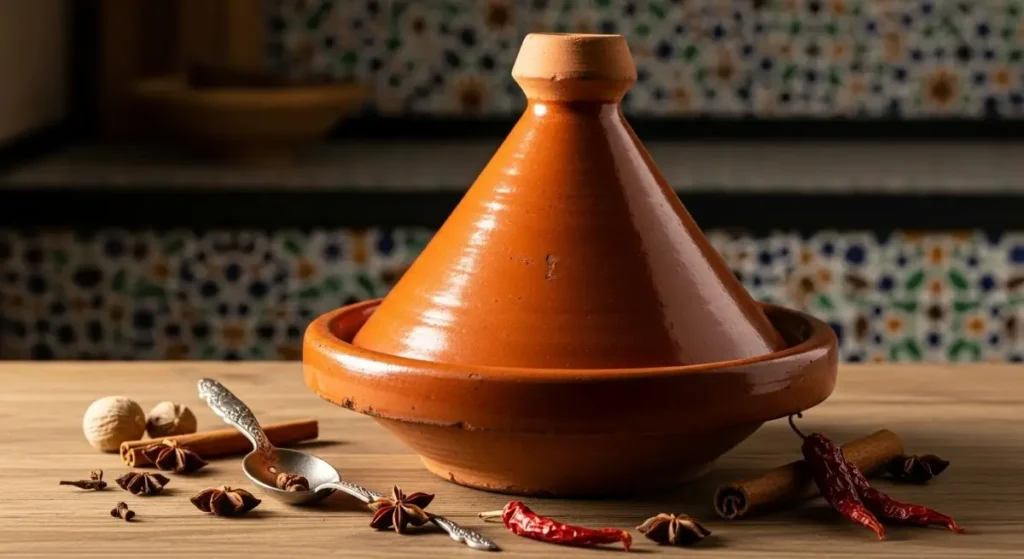
So, what is this tagine? My English passengers asked. Maybe you are asking, too.
It’s simple. You see the clay pot. The one with the funny cone lid. You think that is a tagine. And you are right. But only halfway.
The pot is just a pot. Clay.
The Philosophy Behind Tagine Cooking
The real tagine… that’s a philosophy. A way of life. In my country, the secret to a great tagine is not complicated ingredients. No. The secret is patience. And controlling the heat. Low heat. Very low. For a very long time.
The Genius of the Lid
The lid’s shape is genius, not just for looks. Steam goes up from the food. It hits the cooler top of the cone. It becomes water again. And it drips right back down. A little shower of flavor, again and again. Nothing is lost. Not the juice from the meat. Not the sweetness from the onions. Not the smell of the spices. Everything stays inside. Everything marries.
Alternatives to the Traditional Pot
But listen. You don’t need a special pot from a Marrakech market to start. No. A heavy pot with a good lid works too.
A Dutch oven, you call it. It does the job. What you need is a thick bottom and a lid that fits tightly. That’s it. You trap the steam. You keep the heat low. You let time do its work.
That is the way of the tagine. You don’t rush it. You let it become what it’s meant to be.
The Story’s Main Ingredients: A Taste of a Moroccan Spring
That day on the highway, when Si Hassan’s waiter put the menu on our table, I knew exactly what to order. It was May. Springtime. The markets in Rabat were full of fresh things. New life.
So for our tagine, the choice was obvious. It had to be a taste of the season.
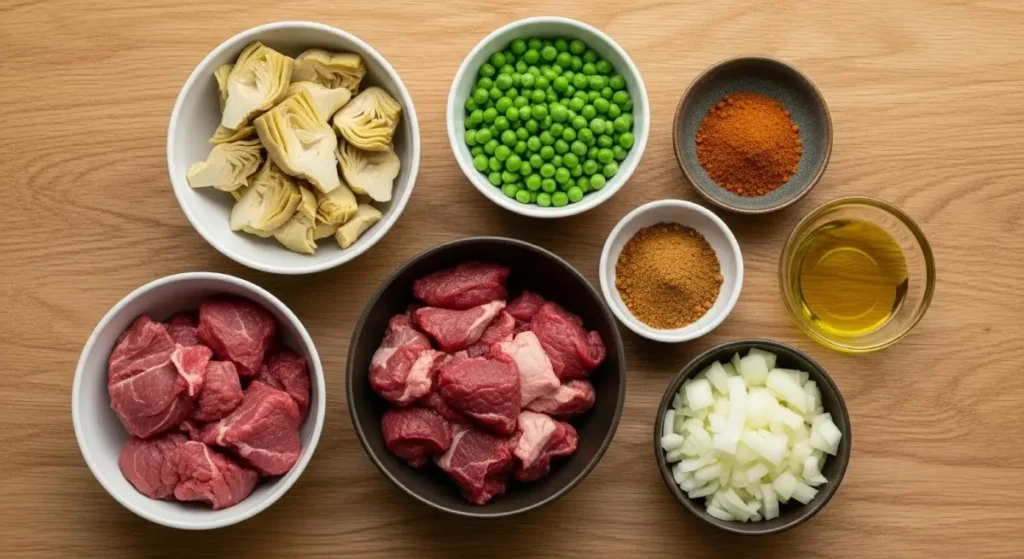
The Meat: The Foundation for a Rich Flavor
For a tagine like this, you need a good, honest cut of meat. Something with a little fat, a little character. Beef chuck is good. It becomes tender like butter when you cook it low and slow. Lamb shoulder is my favorite. It has a deeper flavor that loves spices. Don’t use the expensive, lean cuts. They will only become dry and sad. The slow cook needs a humble piece of meat. That’s where the magic is.
The Stars of the Season: Fresh Peas & Artichokes (Jelbana w Qouq?)
This is the taste of spring in Morocco. Sweet, tender green peas.
Young artichoke hearts have a delicate, almost nutty flavor. We call them “jelbana w qouq?”. In the spring, you see them everywhere. They bring a freshness to the rich meat. A balance. If you can find them fresh, it is a gift. If not, frozen is fine. The soul of the dish will still be there.
Important: Use well-cleaned artichoke hearts, preparing them in a nice round shape to maintain an attractive presentation and ensure even cooking.
The Spice Blend (Ras el Hanout): The Heartbeat of the Dish
Every Moroccan family has its own secret for ras el hanout. It means “head of the shop.” The best spices the merchant has. Cumin, coriander, turmeric, ginger, a little cinnamon, and some black pepper.
You can buy a good blend already made. No shame in that. But mixing your own… that is where you put your own story into the pot.
It doesn’t have to be complicated. Just warm and balanced. This is the heartbeat of the tagine and an essential part of authentic “tagine cooking”.
A Word on Preserved Lemons and Olives
Some people add preserved lemons. Some add olives. I like this tagine pure. Just the meat, the spring vegetables, and the spices. The lemon and olives can be strong. They can shout over the other flavors. For this dish, I prefer to let the sweetness of the peas and the richness of the meat speak for themselves. Simple. Honest.
Step-by-Step Method: The Roadside Stop and Si Hassan’s Wisdom
That day on the highway, we found a place—one of those big service stations. Not a charming little village spot, no. But clean. And my passengers were truly hungry. The owner, a man named Si Hassan, knew me from my years on the road. A good man. He gave us a clean table right away.
The tagines arrived. Small, individual ones, steaming hot. The smell… it filled the air.
My English friends picked up their forks. But I reached for the bread. The khobz?. This is how you eat a tagine. You tear off a piece, you pinch it with your fingers, and you use it like a spoon. You go right into the heart of the dish.
I will never forget their faces. They watched me. Then they put down their forks. And one by one, they picked up the bread and did the same.
Now, I will show you how to build this tagine, just as Si Hassan’s cooks did that day.
Step 1: Build the Flavor Foundation, Slow and Easy
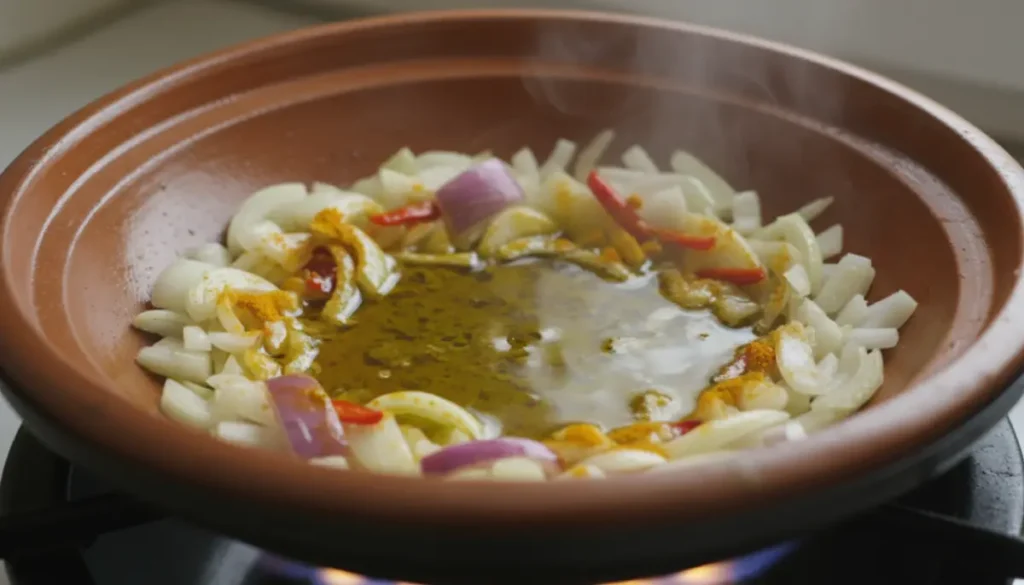
You start with oil in your pot. A good splash of olive oil. Let it get warm, not hot. Add your chopped onions. Let them soften. Slowly. Don’t rush this. This is the foundation of your flavor. The onions should become sweet, almost transparent. This is your first layer of patience.
Step 2: Browning the Meat to Trap the Soul Inside
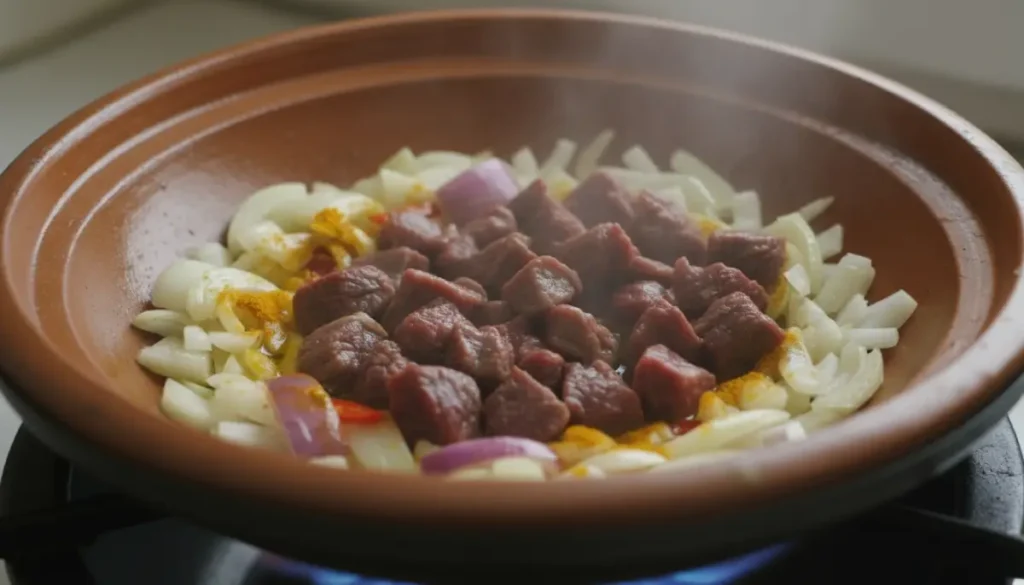
Now, add your meat. Push the onions to the side. Let the meat touch the bottom of the pot. You want to hear a gentle sizzle. Not a roar. Turn the pieces. Brown them on all sides. You are not cooking the meat through.
No. You are creating a crust. A wall. This wall keeps the soul, the juice, inside the meat. This is a crucial step. Don’t skip it.
Step 3: Layering the Spices and Vegetables with Care
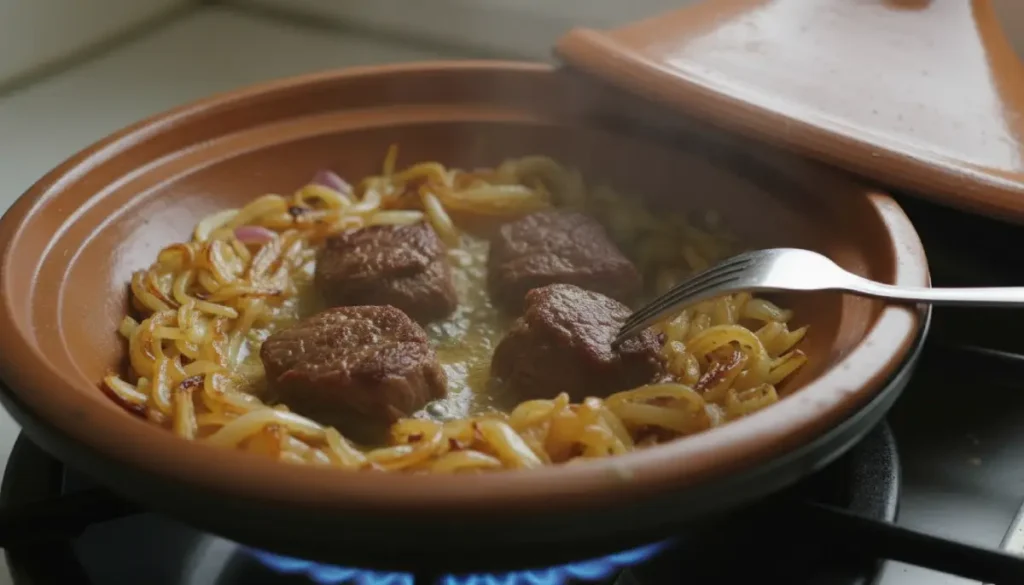
Once the meat is browned, bring the onions back in. Sprinkle your ras el hanout, the salt, and the pepper all over everything. Stir it all together. Let the spices toast for a minute. Let their perfume wake up. Now add your artichoke hearts. Then your peas on top. Don’t stir everything into a mess. Think in layers. Add enough water to come halfway up the ingredients. Not more. Remember, the tagine makes its own sauce.
Step 4: The Final Secret: “Let it Cook Slowly, Very Slowly”
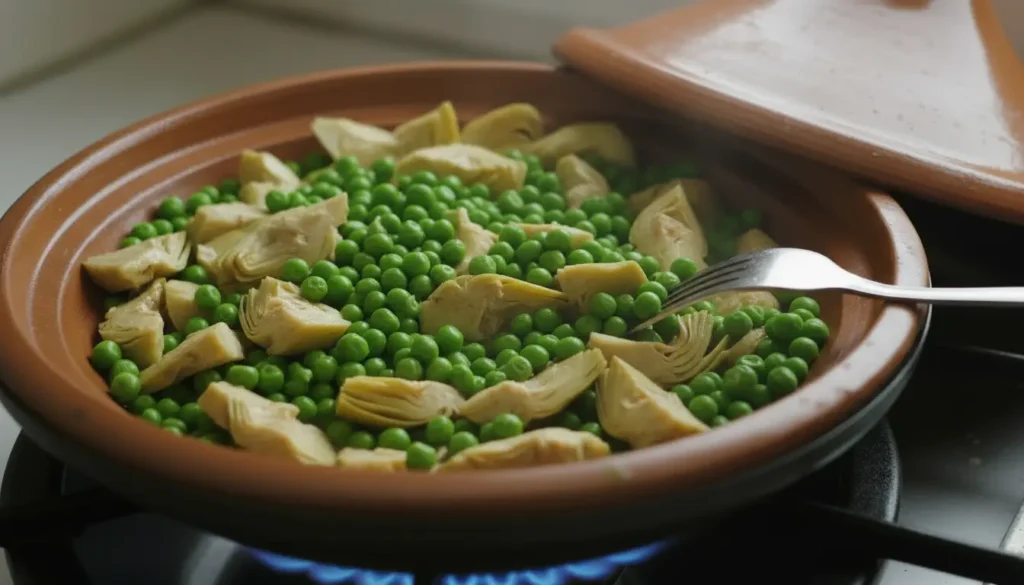
Put the lid on. Turn the heat down to the lowest possible flame. Now, you walk away. This is Si Hassan’s secret. It’s the secret of all Moroccan mothers.
Let it cook slowly. Very slowly. For at least two hours. Don’t peek every five minutes. Trust the pot. Trust the heat. Let time do its work. The meat will become tender. The sauce will become rich. Everything will come together. This is the way.
Video: Your Step-by-Step Guide to the Spring Tagine
Sometimes, a story is best told not just with words, but with a journey through the senses. We’ve captured the essence of preparing this beloved Moroccan Spring Tagine in a special video guide. Watch as we take you through each step, from building the rich flavor foundation to layering the fresh peas and tender artichokes, just as Si Hassan’s cooks would have done. See the magic of slow cooking unfold, bringing the aromas and warmth of Morocco right into your kitchen.
How to Eat Tagine Like a Moroccan: A Lesson in Sharing
How to Eat Tagine Like a Moroccan: A Lesson in Sharing
The food arrived. Four small, steaming tagines. The waiter lifted the lids. A cloud of perfume escaped. The smell of home.
I looked at my English friends. They had forks in their hands, ready. I just smiled. And I reached for the basket of bread. The khobz?.
Bread, the Real Tool for Tagine
In Morocco, we don’t always use forks for a tagine. The real tool is bread. You tear off a good piece. You hold it between your thumb and two fingers. You make a little scoop. Then you go into the pot. You get a piece of meat, some vegetables, and you soak up that beautiful sauce. The bread becomes part of the bite. This is the way.
They watched me. No one spoke. They just watched. I took my first bite. Then, I saw the man next to me put his fork down. He tore off a piece of bread. He tried to copy my fingers. It was a little clumsy at first. But he did it. Then his wife. Then the other couple. Soon, we were all eating with our hands, with the bread. Sharing the same meal, in the same way.
Understanding Through Sharing
And in that moment, something changed.
They were no longer just eating. They were understanding. The smiles on their faces… they were real. Full of joy.
“This is delicious, Khalid,” one of them said. “A brilliant idea.”
And just like that, we were not the driver and his clients. We were friends sharing a meal.
We started talking. About my religion. About their lives in England. About Moroccan customs. The food opened a door between our worlds. A simple tagine on the side of a highway… it connected us all.
What to Serve with Your Tagine
A tagine is a king on the table. Rich. Powerful. But a king needs his court. The dishes you serve with it are important. They support. They don’t compete. Something to catch the sauce. Something to cut the richness.
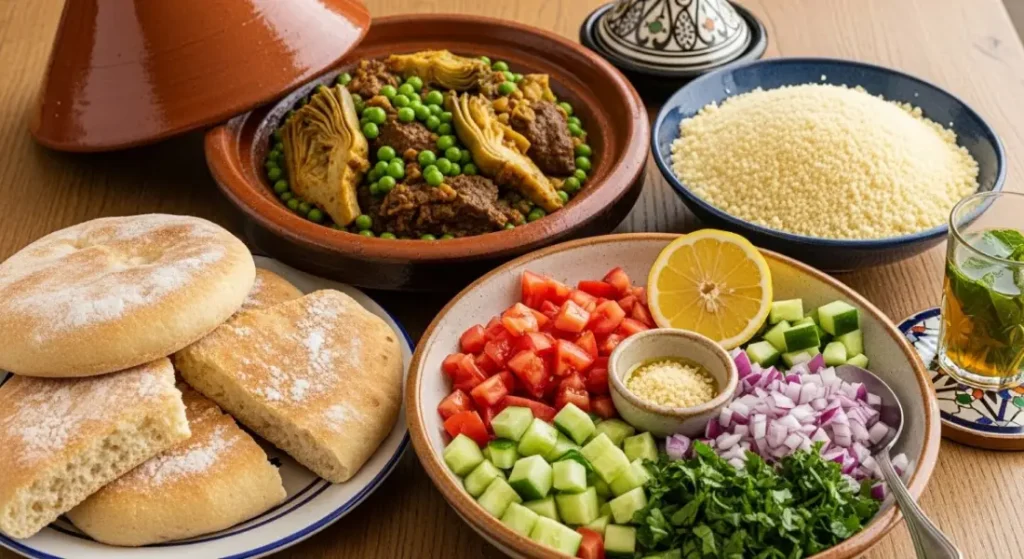
On my table, you will always find these things:
Good Couscous: A Classic Bed for Tagine Cooking
Good Couscous: Not a must, no. But a classic. It’s light. Fluffy. It makes a perfect bed for the tagine. And it drinks up every last drop of that good sauce. No flavor gets left behind.
Fresh Khobz: The Real Tool
Fresh Khobz?: The bread. This is the real tool. Better than a fork. You need it. For scooping. For soaking. For chasing that last piece of meat around the pot. A tagine without bread feels lonely.
A Simple Salad: A Fresh Touch
Keep it simple. Chopped tomatoes. Cucumber. A little red onion. Salt, pepper, and a squeeze of lemon. A bit of olive oil. Finished. It’s there to be fresh. To clean your mouth between rich bites. A bright, clean taste.
Mint Tea: The Final Act
Always. A meal isn’t over until the tea is poured. Sweet. Hot. It helps you digest. But it’s more than that. It’s a signal. Time to relax. Time to talk. The eating is done. The time together is not.
That’s all. Just a few honest things. That’s how you build a real Moroccan meal.
Your Questions Answered by a Rabat Taxi Driver
Do I really need to buy a traditional clay pot?
Honestly? No. It’s beautiful, yes. It makes you feel connected to the tradition. But my mother didn’t always use one. A good, heavy pot with a tight lid will work. A Dutch oven is perfect. The secret is low heat and a trapped cloud of steam. Not the pot itself. Start with what you have. Fall in love with the cooking. Then, maybe, buy yourself a nice clay pot as a trophy.
Can I make this tagine ahead of time?
You can. And you should. A tagine is always better the next day. The flavors need time to sit together. To get to know each other. To marry. All the spices, the sweetness of the vegetables, the richness of the meat… they become one. Make it today, eat it tomorrow. It’s an old secret. The best flavor comes with a little rest.
What if I can’t find fresh artichokes?
Don’t worry. The world is not perfect. If you can’t find fresh artichokes, frozen ones are good. Canned artichoke hearts work too, but be careful. Rinse them well to wash away the salty water they live in. The soul of the dish is the mix of peas and artichokes. Fresh is best, but good is better than nothing.
What is the most important advice for a beginner?
Patience. That is the only word. You will want to lift the lid. To peek. To stir. Don’t do it. Every time you lift the lid, you let the magic escape. Trust the process. Trust the low heat. Put the lid on, turn the fire down, and go drink a glass of tea. Read a book. Forget about the pot for two hours. It knows what it’s doing.
Last Bite
Every journey has to end at the table. This tagine is more than a recipe — it’s a piece of Moroccan spring, a way to slow down and connect with real flavors and real people. Whether you’re making it for family, friends, or just yourself, let patience be your main ingredient.
Ready to bring Morocco home? Try the recipe, share your tagine with someone you love, and leave a comment below — or tag your creation on social media with #MoroccanTagineJourney. Hungry for more? Explore the rest of our Moroccan recipes and let your kitchen become your next adventure!
For more Moroccan culinary adventures and timeless recipes, feel free to explore our homepage.
“Besseha“, to your health, from our table to yours.
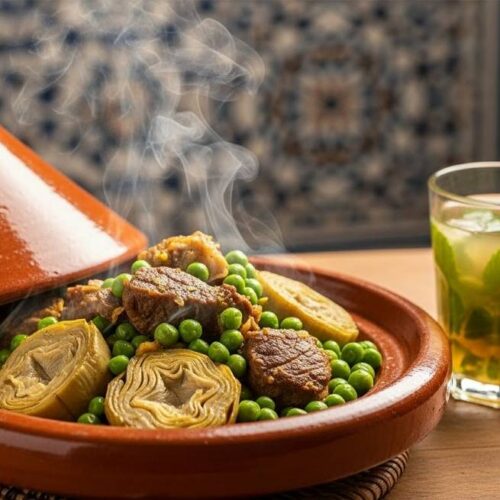
Meat Tagine with Peas & Artichokes (Jelbana w Qouq)
Equipment
- 1 Tagine
Ingredients
Ingredients
- 2 lbs beef chuck or lamb shoulder cut into 1.5-inch cubes
- 2 tablespoons olive oil
- 2 large onions chopped
- 2-3 teaspoons Ras el Hanout or your own blend of cumin, coriander, turmeric, ginger, cinnamon, black pepper
- Salt and freshly ground black pepper to taste
- 1 lb fresh or frozen artichoke hearts
- 1 lb fresh or frozen sweet peas jelbana
- Water
Instructions
Instructions
- Warm the Oil: In a heavy-bottomed pot or Dutch oven, warm the olive oil over low-medium heat. Add the chopped onions and let them soften slowly until sweet and translucent.
- Brown the Meat: Push the onions to the side and add the meat to the pot in a single layer. Brown the cubes on all sides to create a crust and seal in the juices. Don't overcrowd the pot; do this in batches if necessary.
- Add Spices & Vegetables: Return all meat and onions to the pot. Sprinkle generously with Ras el Hanout, salt, and pepper. Stir for a minute to toast the spices. Layer the artichoke hearts over the meat, then top with the peas. Add enough water to come about halfway up the ingredients.
- Slow Cook with Patience: Bring to a gentle simmer, then reduce the heat to the absolute lowest setting. Cover the pot with a tight-fitting lid. Let it cook for at least 2 hours without lifting the lid. Trust the process. The meat should be fork-tender and the sauce rich and flavorful.
- Serve: Serve hot with fresh bread (khobz) for scooping and a side of simple salad.
Notes
Khalid’s Tips
- The Secret is Patience, Not the Pot: A heavy Dutch oven works just as well as a clay tagine. The real magic is low heat and a tight lid that traps the steam. Don’t rush it.
- Better the Next Day: If you have time, make your tagine the day before you plan to eat it. Letting it rest overnight allows the flavors to marry and deepen. The taste is always better on the second day.
- Use Bread, Not a Fork: To eat like a Moroccan, tear off a piece of good bread (khobz) and use it as a scoop. It soaks up the sauce and gives you the perfect bite every time.
Nutrition Information
The figures below provide an estimate of the nutritional value of a dish made with traditional “tagine cooking”, but they can vary depending on ingredients and recipe variations. Fat content, calories, and protein levels depend on the type of meat, amount of oil used, and choice of vegetables and sides.
Most meat-based tagines typically provide between 165 and 360 calories per 100 grams, with a richness in protein, fiber, and essential micronutrients. Leaner recipes often use olive oil or minimal fat, but results vary by cook and regional style.
Here is an overview based on reliable sources:
| Nutrient | Approximate Value per 100g | Comments |
| Calories | Around 165 to 360 kcal | Varies with meat and cooking |
| Protein | 7 to 24 g | High protein content |
| Fats | 2 to 16 g | Depends on cuts and sauce |
| Fiber | 1 to 6 g | From vegetables and legumes |
| Carbohydrates | 5 to 20 g | Present in vegetables and sides |
| Sodium | Variable | Adjusted by salt and marinades |
Values can fluctuate based on ingredients, cooking time, and additional components.
Glossary of Moroccan Terms
| Moroccan Term | Meaning in English |
| Besseha | A warm Moroccan expression meaning “to your health,” often said during meals or toasts. |
| Khobz | Traditional Moroccan bread, often used instead of utensils to scoop food in tagine cooking. |
| Jelbana w Qouq | Green peas (jelbana) and young artichoke hearts (qouq), fresh spring vegetables commonly used in tagine dishes. |
| Ras el Hanout | A traditional Moroccan spice blend meaning “head of the shop,” containing cumin, coriander, turmeric, ginger, cinnamon, and black pepper among others. |
| Tagine | Both a traditional Moroccan dish and the special clay pot with a cone-shaped lid used to cook it slowly. |
📨 Stay Connected with Our Moroccan Kitchen
Don’t miss a single flavorful recipe! Subscribe to our newsletter and get exclusive Moroccan tagine recipes, cooking tips, and seasonal ideas delivered straight to your inbox. From traditional classics to healthy, easy-to-make dishes like our Heartwarming Meat with Peas & Artichokes, you’ll always find something inspiring to cook at home.
Join our community of passionate food lovers and bring a taste of Morocco to your table every week!
📩 Join Our Moroccan Foodie Community
Get the best Moroccan tagine recipes and seasonal culinary tips straight to your inbox.
📱 Let’s Stay Connected!
Love Moroccan cuisine as much as I do? Join me on social media for even more delicious recipes, behind-the-scenes cooking moments, and vibrant food inspiration straight from Morocco!
Follow @TajineRecipes on Pinterest, Instagram, and Facebook — and don’t forget to tag me when you try a recipe. I’d love to see your beautiful creations! 🧡🍲🇲🇦
💬 Have Questions or Feedback?
I’d love to hear from you! If you have any questions, need help with a recipe, or simply want to share your thoughts, feel free to leave a comment below. Your feedback and suggestions help improve the content and build a warm community of Moroccan food lovers. Let’s connect and make this space even more flavorful together!
